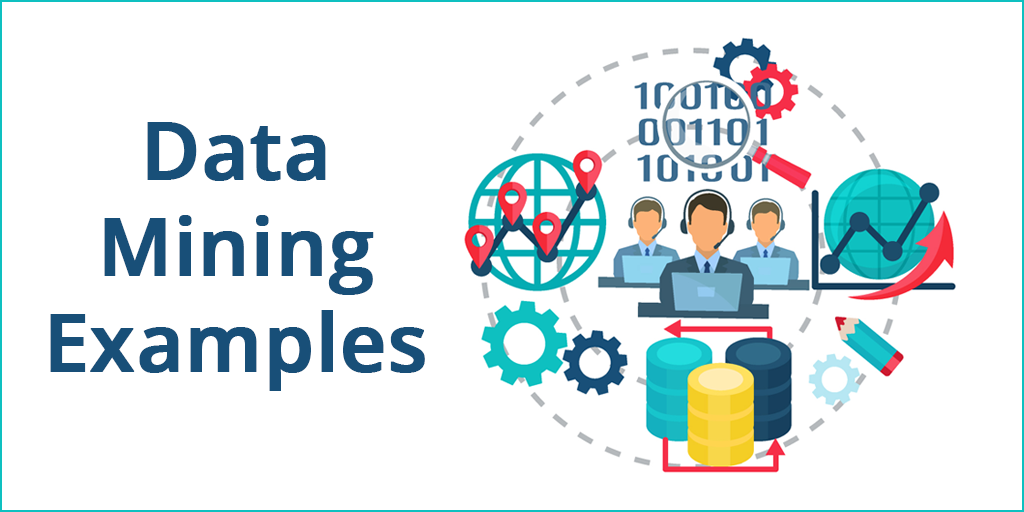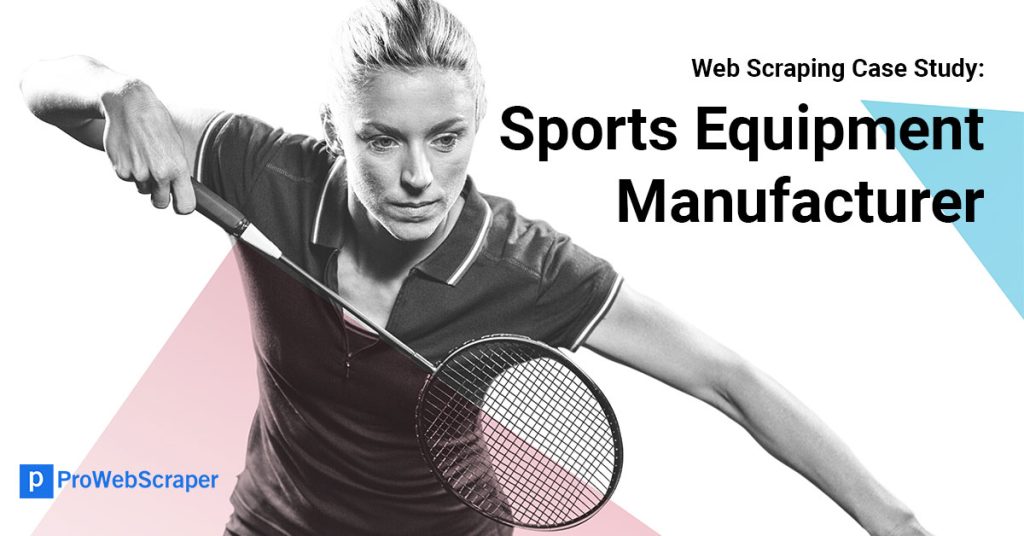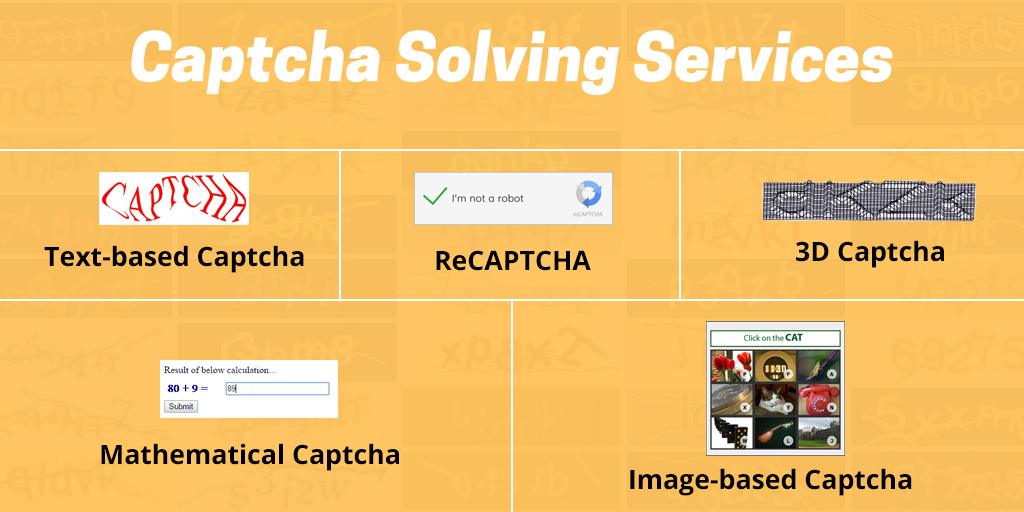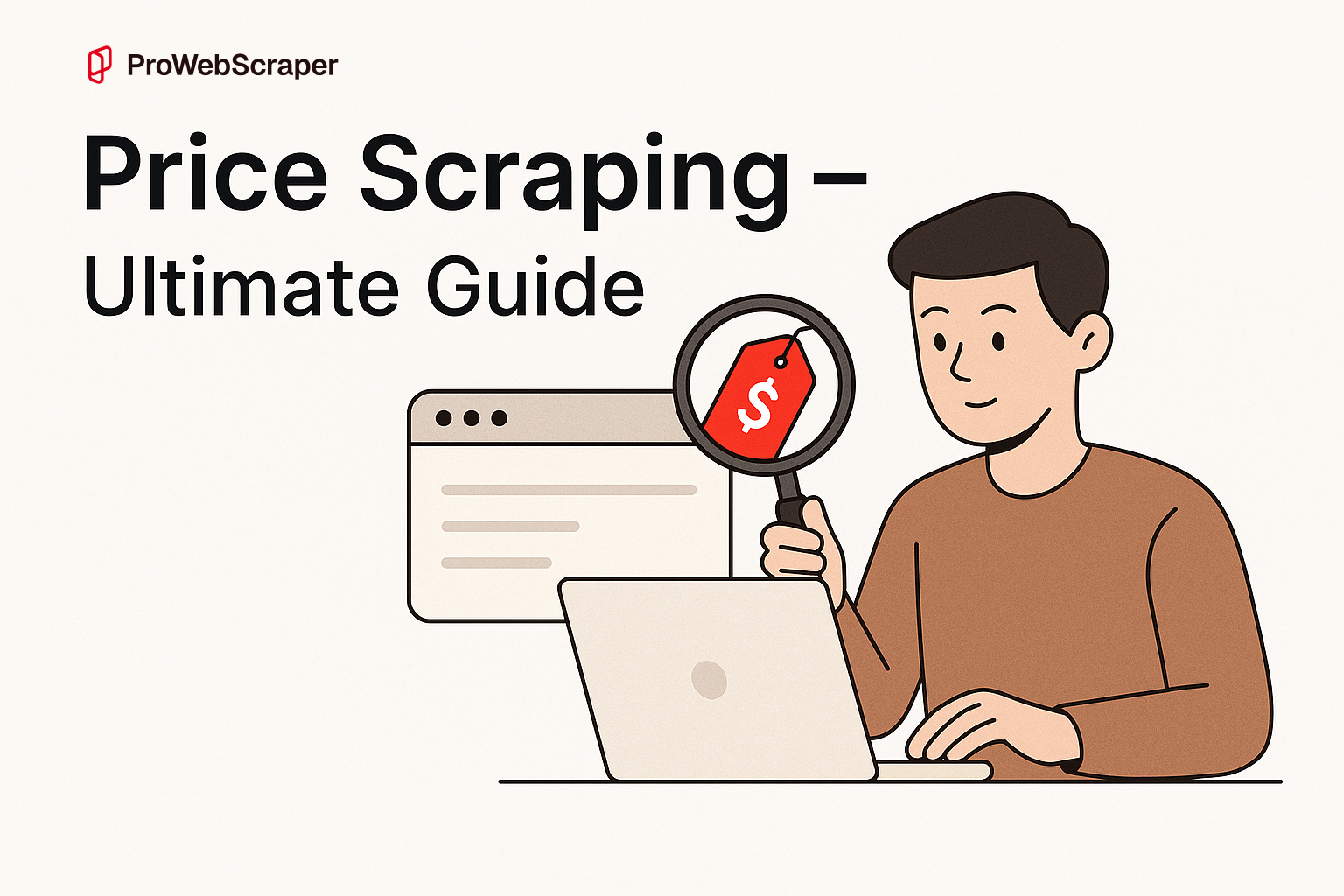
eCommerce is all about prices. The way you devise your pricing strategy determines your success in the ecommerce marketplace. As prices of products are available online, 86% customers compare prices online across platforms before making purchases.
This means that you need to stay competitive price-wise to retain customers and increase sales and market share.
There are various scenarios that can play out and put you on the backfoot. Let’s say, your competitor slashes prices by 10%, disrupting a steady flow of customers you have, and damage your profit margins.
Or someone can just undercut your meticulously planned holiday discounts, adversely affecting your peak-season sales.
If you find these scenarios familiar, you may wonder about the following questions:
- How can we increase revenue and profit margins while staying competitive?
- How do we adjust prices faster than competitors?
- How can we monitor, match, and compare prices across global competitors seamlessly?
Retailers who fail to keep pace with competitor pricing lose up to 30% of sales. Customers are not going to wait- they will purchase it from wherever they will get it cheaper.
How to Stay Updated with Competitor Pricing
The solution is that you stay updated with competitor pricing on a minute-to-minute basis. How do you keep track of competitor prices? The only way you can keep track of prices in the ecommerce marketplace is through price scraping, the automated way to collect pricing data from hundreds of competitors and retailer websites. Price scraping enables you to track the market in real time, monitor emerging and changing trends and modify your pricing strategies accordingly.
According to BCG, when a grocery chain started monitoring competitor prices in a systematic way, it discovered that products were priced 20–30% lower than necessary. By placing their prices right below competitors’ prices, the company witnessed a significant surge in their profits without any adverse effect on sales volume.
Similarly, McKinsey reports that dynamic pricing, powered by competitor price data, boosts revenue by an average of 5%.
Let’s explore what price scraping is, how it works, how it can transform your pricing strategy and keep you ahead of competition through this ultimate guide.
What is Price Scraping?
Price scraping is simply automating the extraction of the key data you need—like pricing, discounts, stock data, and shipping costs—from ecommerce websites, marketplaces, or retailer sites. You can leverage this data to keep track of your competitors, analyze pricing trends, and modify their strategies to stay competitive and profitable.
Quick Facts: Amazon has been ranked as the lowest-priced retailer for seven consecutive years, according to Profitero’s annual Price Wars study. How does Amazon consistently undercut its competitors? The answer is simple- by capitalizing on price scraping.
It’s not anybody’s monopoly though. You can also get the same competitive edge through price scraping. You can get a real-time insight into market trends and make sure your prices remain competitive.
Types of Data You Can Scrape
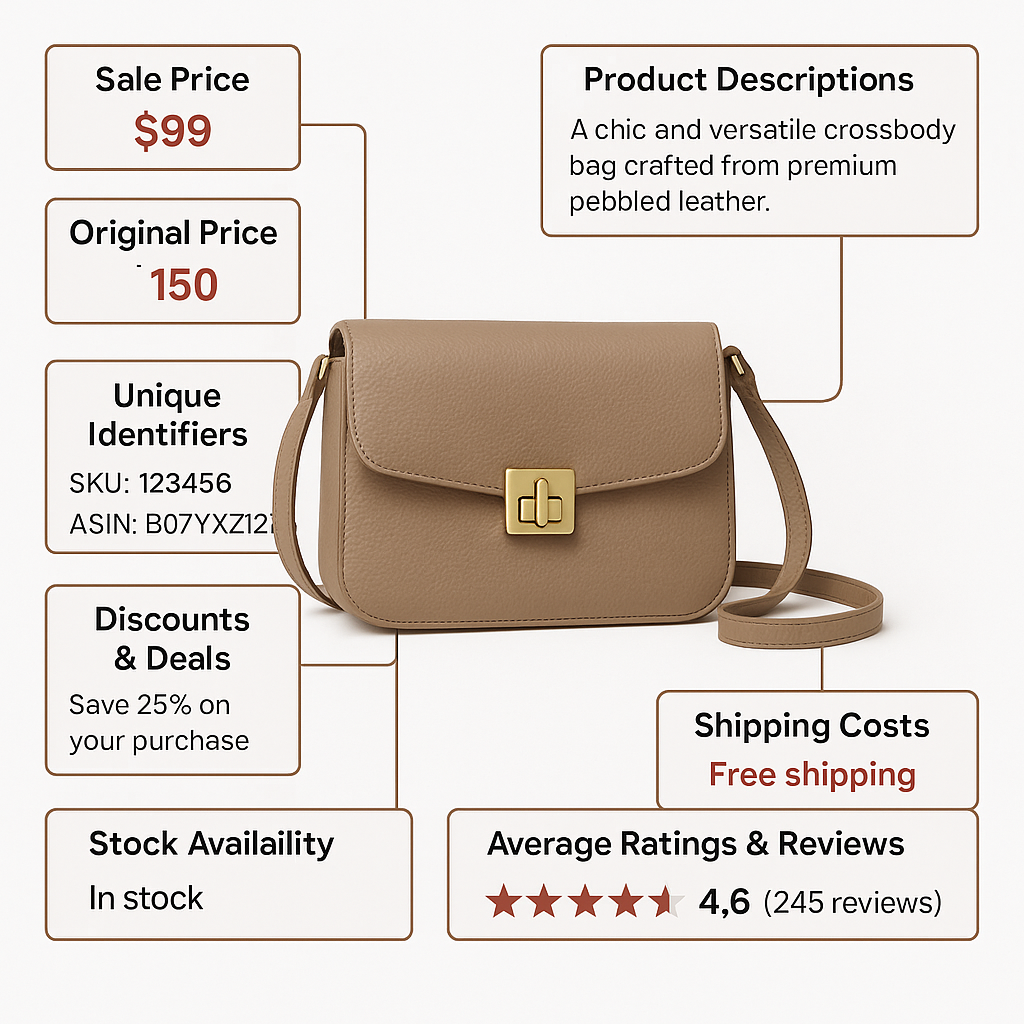
With the help of price scraping, you can scrape different kinds of data points that you need. This kind of varied data provides you a unique insight into the market trends. Here’s what you can scrape:
- Prices
- Sale Price: The discounted or promotional price.
- Original Price: The regular price before discounts.
- Price by Variation: Track prices for different product variations (e.g., sizes, colors).
- Price by Location: See how prices vary across regions or markets.
- Product Descriptions: Scrape detailed descriptions to track how competitors position their products.
- Product Specifications: Monitor product features like dimensions, materials, or functionality for comparison.
- Unique Identifiers: SKU (Stock Keeping Unit), ASIN (Amazon Standard Identification Number), or Barcode: Essential for matching products accurately across competitors’ catalogs.
- Discounts & Deals: Spot flash sales, bundled discounts, or coupon offers to respond proactively.
- Stock Availability: Track if competitors are running out of stock, creating opportunities to boost your own sales.
- Shipping Costs: Track delivery fees and estimated shipping times to discover potential cost advantages.
- Average Ratings & Reviews: Get hold of customer feedback metrics, such as star ratings and the number of reviews, to analyze competitor performance and customer sentiment.
As you can see, price scraping is not merely price points that you can scrape. It has many dimensions. Now that we have a fairly good idea of what price scraping is all about, let’s find out how it can transform your ecommerce business.
Key Benefits of Price Scraping for E-commerce Businesses
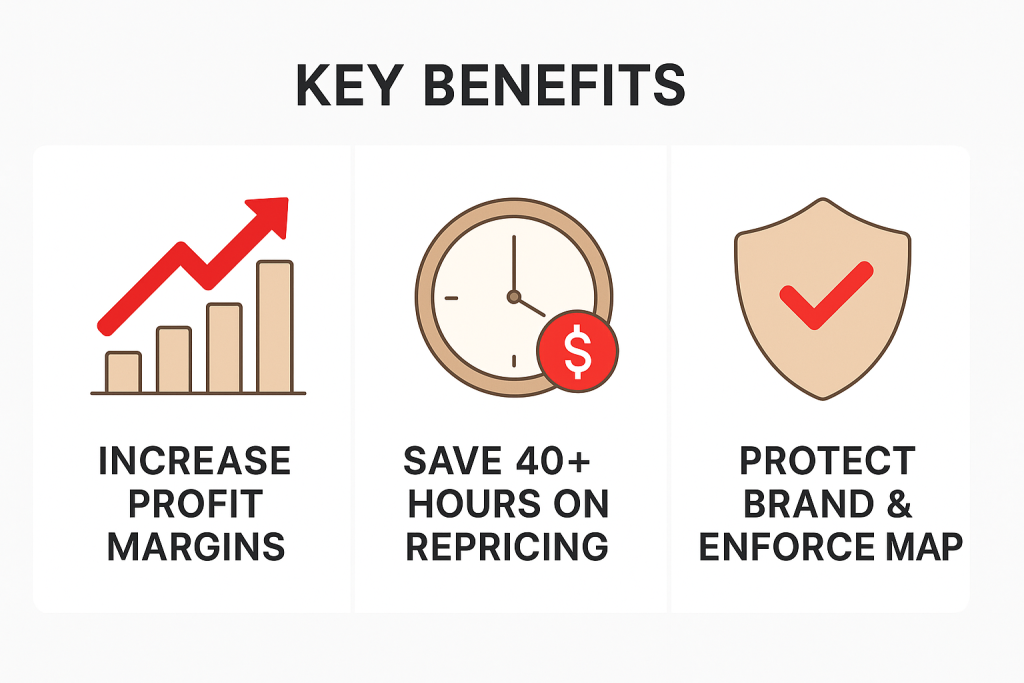
Price scraping doesn’t end with extracting data. It’s about leveraging that data to streamline your pricing strategy according to market trends and situation. It can, thus, help you protect your brand and boost overall efficiency.
Here’s how price scraping can enhance your ecommerce business:
1. Increase Profit Margins and Revenue
You can track competitor prices and align your prices accordingly to benefit from this competitive edge. This will allow you to stay ahead of competition and optimize profits. Businesses that capitalize on such dynamic pricing strategies witness up to 6% boost in profit margins and 5–20% increase in revenue.
Example: Make use of price scraping to monitor your competitors on key marketplaces like Amazon, eBay, and Google Shopping. This will give you real-time insights. So you will be able to adjust your prices as per changes in market trends or competitors’ pricing strategies.This will enable you to quickly respond to price changes, stock levels, or promotions, ensuring you remain the preferred choice for customers.
2. Save 40+ Hours on Repricing
eCommerce works at a fast clip. Data keeps changing. Collecting data manually can not only be a nightmare but also consume a lot of your valuable time and energy. According to an estimate, it could take up to 40 hours per month to track competitor prices and still it could be unreliable or inaccurate data.
Price scraping works because it automates this process. It provides accurate, real-time insights in a fraction of time. This allows you and your team to focus on devising business strategy instead of hunting for data.
3. Protect Your Brand and Enforce MAP Policies
Securing profits is one challenge. Protecting your brand and enforcing MAP policies is another because unauthorized sellers often violate Minimum Advertised Pricing (MAP) policies. This can result in price erosion and adversely affect your brand. According to Harvard Business Review, 50% of unauthorized retailers breach MAP agreements, compared to 20% of authorized sellers.
If you can track retailer pricing on their websites or marketplaces, you can spot MAP violations, send notices to authorized sellers, and remove unauthorized sellers. This lets you maintain brand integrity and pricing consistency.
Example: A fashion brand made use of price scraping to monitor its products across major retailer sites and marketplaces. They could spot multiple unauthorized sellers and enforce MAP compliance, protecting both their brand and their revenue.
As you can see, how price scraping can work wonders for profit and brand integrity. Now let’s explore the legality of price scraping which is not merely crucial but also tricky.
Is It Legal to Scrape Prices from E-commerce Sites?
In one word- yes. It is perfectly legal to engage in price scraping as long as you do it in a lawful manner and ethical way. While price scraping is a powerful mechanism to get the data you need, it needs to be used in a responsible way that ensures compliance with ethical practices and legal norms. Here’s what you need to know:
- Focus on Public Data
As long as you extract publicly available information, like product prices and descriptions, price scraping is legal and is generally permitted. Avoid accessing password-protected or restricted areas to stay within legal limits. - Respect Website Rules
Respect the guidelines provided in a site’s robots.txt file and avoid relentless scraping that might overwhelm the servers. - Avoid Personal Data
Don’t scrape anything other than prices and product specs. Don’t go anywhere near personal data to comply with privacy laws like GDPR and CCPA. - Leverage Proven Tools
Don’t rely on substandard free tools. Capitalize on tools like ProWebScraper to ensure compliance by automating safeguards, including rate limiting, robots.txt adherence, and avoiding restricted areas.
When you follow the strategies listed above, price scraping is perfectly legal. It is not only a legally fair process but also a great tool for getting ahead of competition. Learn more about compliance and best practices in our full blog here.
Now that we have clarified the legality of price scraping and its significance, let’s see how it works. Let’s explore how it can be implemented for your ecommerce brand, marketplace or retail shop.
How Does Price Scraping Work?
Price scraping is basically about automating the process of collecting, storing, and analyzing data to make informed pricing decisions. Here’s a detailed explanation of how it works:
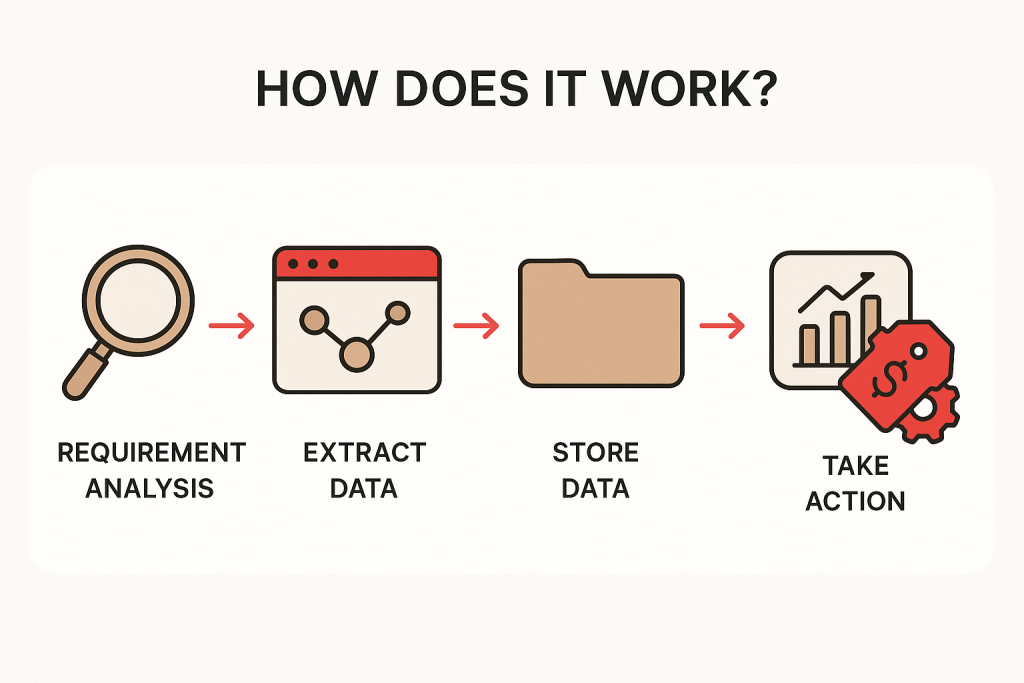
1. Requirement Analysis
- Target Websites & Data Points: Find out competitors or marketplaces to track and specify data points like prices, discounts, stock availability, and shipping costs.
- Set Scraping Frequency: Decide the update intervals (hourly, daily, or weekly) based on market dynamics.
2. Scrape Data
Making use of a price scraper, you, then, scrape data from the target websites. This includes prices, product descriptions, discounts, and other key data points.
Example: A tool like ProWebScraper visits competitor websites, identifies the pricing elements on product pages, and scrapes the data into a structured format like csv, json, excel.
3. Store Data (Including Historical Records)
Save scraped data securely in formats like databases, CSV, or Excel files. Maintaining historical records helps analyze trends and streamline strategies.
4. Analyze Data
- Leverage tools like Tableau or Power BI to create powerful visualization of the data and convert them into trends and identify actionable insights, such as price drops or stock shortages.
5. Take Action
Insights obtained from such in-depth analysis are used to make informed pricing decisions.
- Dynamic Adjustments: Automatically update your prices to match or undercut competitors.
- Promotional Strategies: Plan discounts or sales based on competitor trends.
- Stock Management: Optimize inventory based on competitor stock availability.
In the following steps, we will explore how to implement price scraping with the help of different methods and tools.
3 Ways to Implement Price Scraping
There are different ways to leverage price scraping based on your resources, technical skills, and business needs. We will explore three major ways, their respective benefits, and points to consider regarding each one.
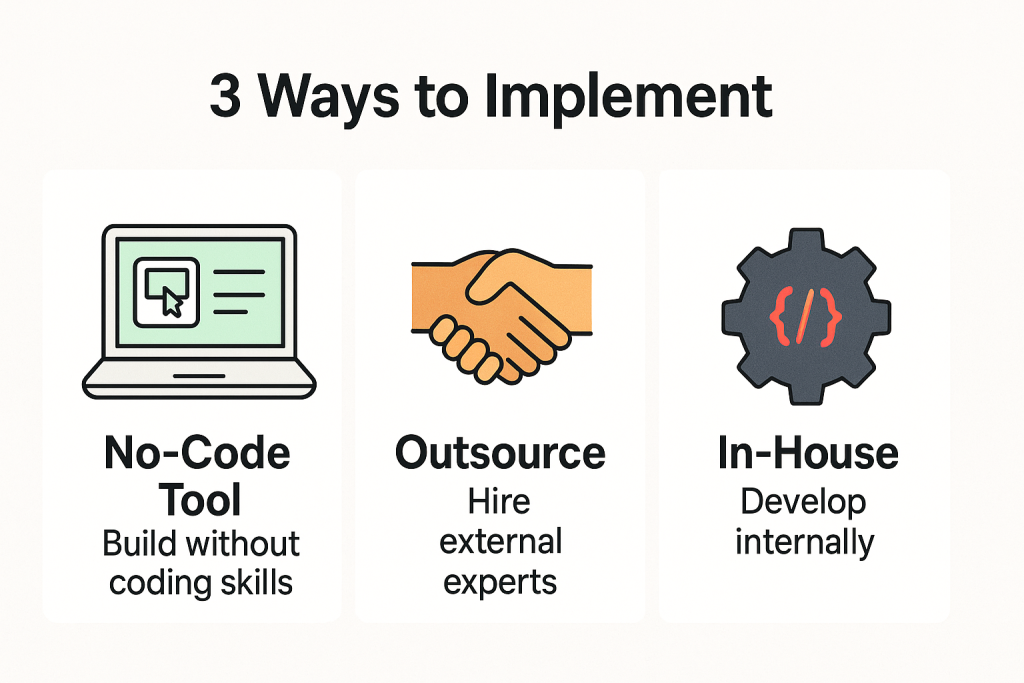
1. No-Code Web Scraping Tools
For non-technical users not having programming skills, no-code tools are best. They let you set up scrapers and start extracting data without any technical knowledge.
- Best For: Businesses needing fast, scalable scraping without hiring developers.
- Recommended Tool: ProWebScraper
- Key Benefits:
- Easy setup with no coding.
- Scalable for thousands of sites.
- Features like IP rotation and CAPTCHA bypass.
- Cloud-based for flexibility.
- Considerations:
- Limited for highly customized scraping needs.
- Basic knowledge of HTML or XPath may help for fine-tuning.
2. Outsource Scraping Services
If you don’t want any hassle of setting up the scraper, legality of data extraction etc., outsourcing may be ideal for you. It assigns the entire scraping process to a service provider, from setup to data delivery and sets you free.
- Best For: Businesses needing reliable data without managing scrapers.
- Recommended Provider: ProWebScraper’s Managed Scraping Service.
- Key Benefits:
- No technical involvement—receive clean, accurate data
- Providers handle updates and anti-scraping measures
- Customizable scraping for your needs
- Service level agreement for data quality & accuracy
- Customized reports & alerts for pricing dashboards
- Considerations:
- Costs more than other no code scraping tools.
3. In-House Scraping
If you like to get involved and do it yourself, you may opt for an in-house scraping solution. You can customize it and use it as per your requirements and process using tools like Python, Scrapy, or BeautifulSoup.
- Best For: Companies with dedicated scraping technical teams
- Key Benefits: Fully customizable for complex requirements.
- Considerations:
- Requires technical expertise and maintenance.
- High setup and ongoing costs for staffing and technology.
Cost Comparison Table
| Approach | Setup Cost (USD) | Monthly Maintenance Cost (USD) | Notes |
|---|---|---|---|
| No-Code Tools | $0 | $50–$300 | Affordable for small to medium businesses with limited needs. |
| Outsourced Services | $100 –$1,000 | $100–$2,000 | High-quality data with no internal effort but higher recurring costs. |
| In-House Solutions | $5,000–$10,000 | $2,000–$10,000 | Requires a technical team; includes engineering, tools, and infrastructure costs. |
Well, price scraping is definitely a powerful tool but it has its own challenges that can overwhelm you. It can have an impact on your resources, cause data accuracy issues and even legal trouble. Let’s understand these challenges and ways to navigate them effectively.
What Are the Challenges You’ll Face While Price Scraping?
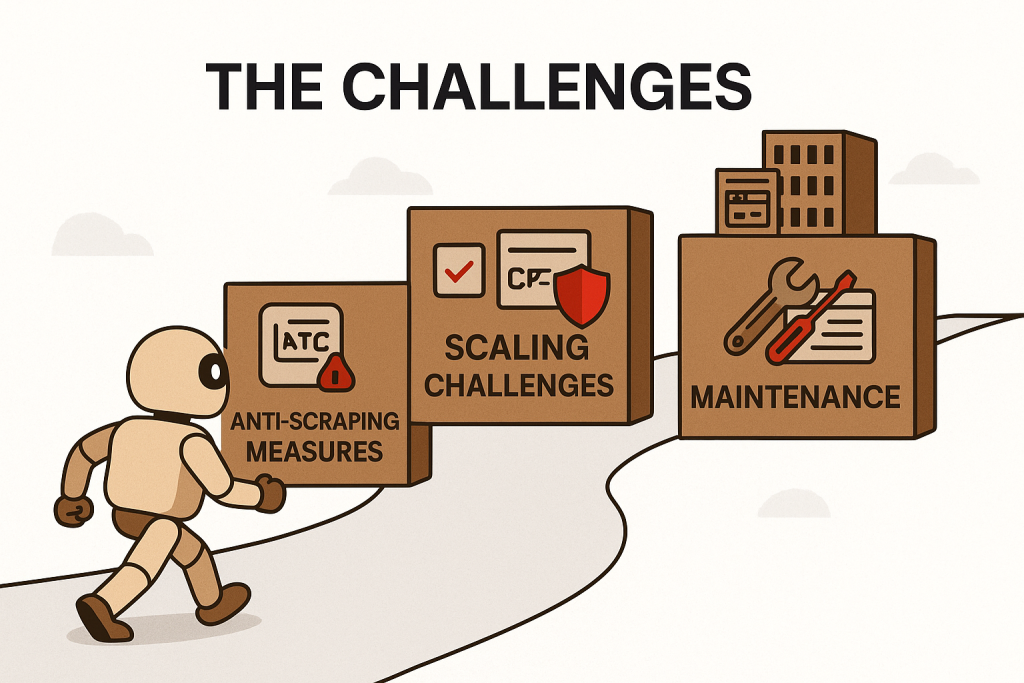
1. Handling Anti-Scraping Measures
Websites make use of powerful anti-scraping measures such as CAPTCHAs, IP blocking, and rate limiting to stop bots from collecting data. It is not possible to bypass them using manual methods or free tools. You need highly sophisticated tools and frequent updates to bypass them.
Without access to these tools and right scraping strategies, data collection can turn out to be futile with inaccurate and unreliable data as the outcome.
Example: Platforms like Amazon and Google Shopping block repeated requests from the same IP or force CAPTCHA verification.
2. Scalability in Implementation
You can perhaps extract data manually or using a free web scraping tool from a few web pages. How to do it for hundreds of web pages. You will need to scale it up as your business grows. You will need to extract data from multiple websites and massive datasets.
Your system will collapse trying to scale it up using manual data collection methods or free tools. It’s a tough task trying to scale up data extraction, maintaining data accuracy and quality.
3. Daily Maintenance of Scrapers
Setting up the scraper once is not the end of the process. Websites keep changing their website structures, navigation, or URL patterns. This can cause your scrapers to break down and disrupt your data extraction.
Therefore, you need to regularly maintain the scrapers and monitor website changes and update the scraper accordingly. However, this requires significant resources and technical know-how.
While price scraping offers immense benefits, it does come with its challenges. However, with the right tool, these hurdles can be easily overcome—this is where ProWebScraper stands out as the number one solution.
ProWebScraper: The #1 Solution to All Price Scraping Needs
A basic tool will only fetch you data from an odd web page and that too not so accurately. Tackling web scraping challenges such as anti-scraping measures, scaling up data extraction and maintaining scrapers requires a sophisticated and advanced best web scraping tool like ProWebScraper.
ProWebScraper is the complete solution, tailor-made to tackle these tricky issues and provide a hassle-free price scraping experience.
We take care of each aspect of the process and set you free. Whether it is data collection or generating actionable insights, we take care of everything. You can forget the woes of price scraping and channelize all your energy on the core business functions.
Let’s See What Makes ProWebScraper the Complete Solution
1. End-to-End Price Scraping
With ProWebScraper Managed Services, you will be at ease when it comes to price scraping.
We scrape 2,500+ websites daily, handling anti-scraping with advanced IP rotation and CAPTCHA-solving while proactively maintaining scrapers to deliver 100% accurate, uninterrupted data at scale.
Whether tracking prices, stock levels, or discounts, you’ll always have reliable data.
2. Actionable Reporting and Insights
Transform massive chunks of data into crisp insights:
- Custom Reports: Customized to your business needs.
- Real-Time Alerts: Notifications for key changes like price drops or stock updates.
- Dynamic Dashboards: Track the trends with user-friendly, customizable dashboards.
3. Easy Integration into Your Workflow
We make sure scraped data blends effortlessly with your systems:
- Connect with BI tools like Tableau and Power BI for more in-depth analysis.
- Leverage our API to integrate into your platforms.
- Sync with cloud apps like Google Sheets, AWS, or Dropbox for easy sharing.
4. Scalable and Maintenance-Free
ProWebScraper’s cloud-based infrastructure manages projects from small-scale to scraping 500+ websites at once. We proactively monitor, fix, and update scrapers, so you spend no time on maintenance.
5. Dedicated Support for Your Business
We provide robust and reliable support from beginning till end. From the day the setup is done to data delivery, you have our team at your disposal for smooth price scraping and constant support.
At present, ProWebScraper has already devised solutions for the existing price scraping challenges and providing quality price data extraction. However, we are also working on integrating AI into price scraping to transform the capabilities of our existing price scraping tools. We intend to redesign the price scraping process, powered by AI and rewrite the rules of the game.
Let’s explore how AI will impact key areas of scraping scraping.
The Future of Price Scraping: AI-Powered Efficiency
With advancements in AI, price scraping will get 50% faster than existing tools. AI will junk all the manual processes and significantly improve data accuracy, making it the future of competitive pricing strategies.
1. Transforming Scraper Building and Maintenance
At present, when you want to build a scraper for a single website, it will take an entire day to write the code. However, no-code tools have brought it down to 10 minutes with the help of point-and-click interfaces. When AI capabilities take effect, it will eliminate the manual part entirely.
It will automate the process by effortlessly detecting and extracting the data you need. Initially, AI training may require some resources but it will empower businesses to extract data from hundreds of sites in a matter of hours.
Unlike today, AI will automatically adapt to website changes, rework the scrapers to match updated HTML structures without manual intervention and yet produce consistent data flow.
2. Overcoming Anti-Scraping Systems
AI will be able to bypass anti-scraping mechanisms much more efficiently and easily by mimicking human behavior such as:
- Simulating browser fingerprints and user activity to avoid detection.
- Dynamically adjusting scraping patterns to bypass restrictions.
This will expedite data collection and remove bottlenecks from data extraction even from the most secure websites.
3. Ensuring Data Quality and Analysis
Today, one may need to carefully go through the scraped data and ensure data quality. AI will put an end to that issue by automatically detecting anomalies and inconsistencies, spotting incomplete fields and rescraping automatically to fill gaps.
With AI, it will be easier and quicker to turn raw data into actionable insights. It will generate in-depth reports and devise tailored dashboards to suit your needs. This will replace the existing, tedious QA and power the decision-making process with speed and accuracy.
Some industry trends about price scraping through AI
- The global web scraping software market is expected to grow at a CAGR of 11.9% to 18.7%, from 2023 to 2030.
- The price intelligence market, which relies heavily on price scraping, is projected to reach $12.2 billion by 2027, driven by increasing e-commerce competition.
- The global e-commerce sector, a major user of price scraping tools, is anticipated to grow to $8.1 trillion by 2026, further fueling demand for data extraction solutions.
Conclusion: Take Your Price Scraping to the Next Level
Price scraping is a compulsion, the new normal of ecommerce business. It’s the only assured path to business success in the ecommerce marketplace. By tackling challenges such as anti-scraping systems, scalability, and scraper maintenance, tools like ProWebScraper enable businesses to stay ahead of their competition.
With price scraping technology, you can:
- Increase Revenue: Stay ahead with dynamic pricing strategies and competitive positioning.
- Boost Profit Margins: Identify pricing opportunities to adjust rates intelligently.
- Save Time and Resources: Automate data collection and maintenance, freeing up your team for strategic tasks.
- Enhance Decision-Making: Leverage real-time, accurate data to drive smarter business actions.
- Protect Your Brand: Monitor and enforce MAP policies to safeguard your market presence.
Price scraping is the key to competitive pricing. Traditional methods of price scraping cannot help you anymore. Capitalize on the power of price scraping to track competitor market, optimize pricing, and scale effortlessly.
Get started today—book a demo with ProWebScraper.
